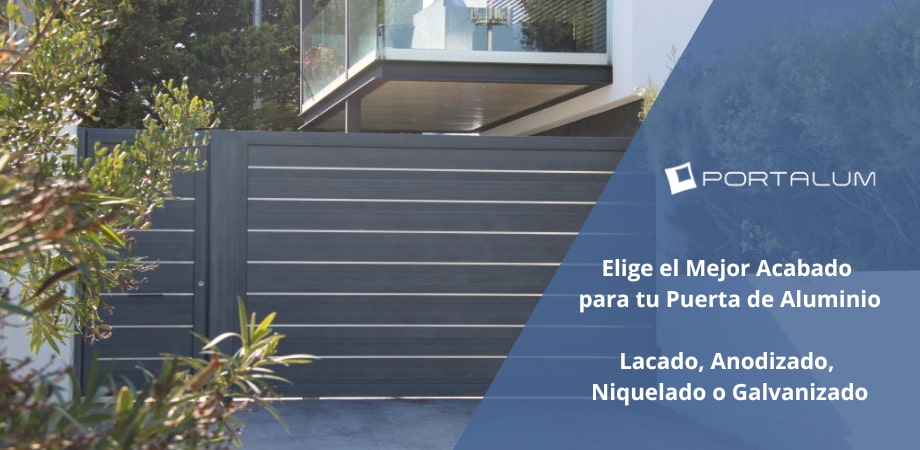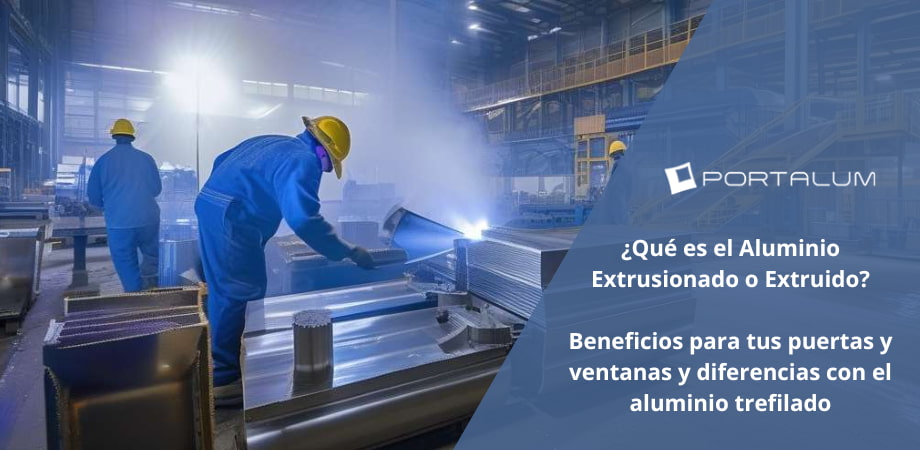Treatments for aluminium doors, such as lacquering, anodising, galvanising and nickel-plating, allow the materials that compose them to gain resistance.
Surely you have already heard these names, but you have not found any explanation about their usefulness, how they are applied or even what they are. They are technical terms within construction and metals that we will explain in detail.
Luckily for you, at Portalum we tell you about it in detail.
What is Lacquered Aluminium?
Lacquering is a treatment that consists of applying several layers on a material, such as the aluminium of a door. These can be more or less dense, transparent or coloured, glossy or matt, but in all cases they guarantee a homogeneous surface, which offers good resistance to friction.
It also protects against abrasion, scratching and wear caused by use, especially if we combine it with the qualities of base materials such as aluminium, which provides better characteristics than, for example, iron, whether lacquered or anodised.
Lacquered aluminum is as beautiful as it is useful, as you will get a door that is difficult to damage and with an aesthetic of your choice. It is possible to apply pigmented lacquers, such as those based on polyurethanes, or vinyl lacquers, perfect for creating a resistant outer film.
When it comes to choosing between galvanized sheet metal or aluminum, there is no doubt that aluminum is presented as the first choice in terms of long-term durability. Lacquered steel would remain as a third option.
It is also a treatment that is usually applied to aluminum fences.

You may also be interested in:
- What is Extruded or Extruded Aluminum?
- How should you choose the door of a commercial premises?
- Types of Garage Doors
What is Anodized Aluminum?
When it comes to knowing the meaning of anodizing and choosing between anodized or lacquered aluminum , we want to make one thing clear:
This procedure is what gives aluminium doors for shops the oxide layer that protects the material. It consists of modifying the surface of the metal to oxidize it and create a layer of alumina a few microns thick that protects the rest of the piece.
But it is also possible to stain the surface by anodizing. While at first only natural gray was achieved, today the range of colors extends from black and gold to blue or green. This treatment is also applied to the iron, turning it into anodized iron.
To achieve anodizing, the aluminum part is used as the anode of an electrical circuit subjected to electrolysis. Thus, this material achieves one of its main characteristics: durability.
What is Galvanized Aluminum?
Galvanized steel or aluminum? Aluminum again.
With aluminum galvanizing , it is possible to cover one metal with another. This electrochemical process, whose name may ring a bell, allows the surface of a given metal to be protected with a layer of a more resistant one.
One of the most commonly used is zinc over iron, as the former metal oxidizes earlier and creates a protective layer over the latter. However, don’t think that all metals are susceptible to combining with each other.
For galvanizing to work, the materials cannot be dissimilar or have a different potential for oxidation. In addition, heat affects in some circumstances. For example, galvanized steel will start to rust if it harbors water above 60°C.
Various finishes can also be mixed, such as lacquered galvanized steel.

What is Nickel-Plated Aluminum?
This technique consists of obtaining a nickel metallic coating based on electrolysis. The aim is to increase corrosion resistance, but ornamental motifs can also be created.
With this nickel plating, different qualities and results are achieved. Matte offers thick layers of nickel and gloss allows for the creation of a reflective surface.
As you can see, galvanized and nickel-plated, as well as other treatments, are essential to protect roll-up aluminum doors and other essential elements of your home or business.
Do not hesitate to consult our services!











